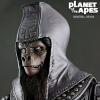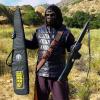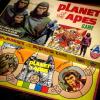|
PLANET OF THE APES COLLECTIBLES #06 |
Updated: February 26, 2025




































































































Planet of the Apes began its life as a mainstream hit. When producer Arthur P. Jacobs brought his version of Pierre Boulle's
novel to the screen, he had no idea that it was going to be anything more than a moderately-budgeted, one off science fiction
feature. The cast was headlined by a single big name Charlton Heston but that was no guarantee of success. Heston was a marketable commodity at the time, but he had participated in his share of flops.
The 1968 movie opened with a short prologue inside a spaceship. Col. George Taylor ( Heston ), one of four astronauts on board,
gives a mournful monologue before joining his fellows in deep sleep. Approximately six months later, their ship crash-lands on an unknown planet. The survivors Taylor, Landon ( Robert Gunner ), and Dodge ( Jeff Burton ) emerge from the vessel to explore their new world, searching for the basics of survival, food and water. Soon, they discover that their new home is inhabited. There are other humans, but they are mute, and they are treated like cattle by the dominant species. On this planet, evolution has favored the apes, who have developed into the walking, talking, thinking rulers of a society where tolerance is minimal, and superstition is valued over science.
The movie was a hit and created a firestorm of buzz. As more films were quickly planned, toy makers raced to stock the shelves. Mego won the race for the rights for action figures, and well, their popularity is legendary in the toy circles. Almost every major toy maker in the 1970s dabbled in the Planet of the Apes and the more popular items are discussed herein.
|
 HOME
HOME
 About
About
 EMail Me
EMail Me TOP |
TOP |  PREVIOUS ITEM | NEXT ITEM
PREVIOUS ITEM | NEXT ITEM  ( 13 of 38 )
( 13 of 38 )




































































































